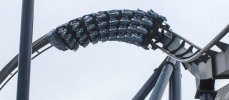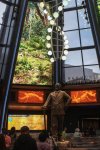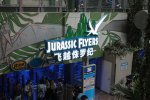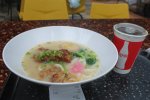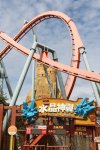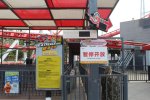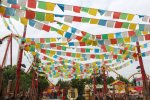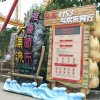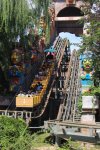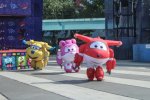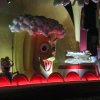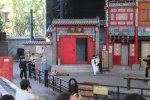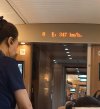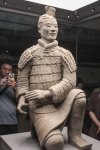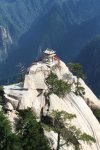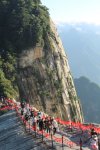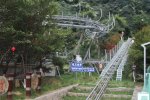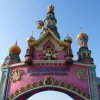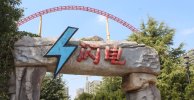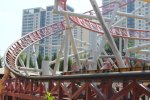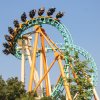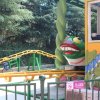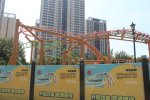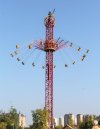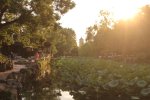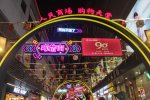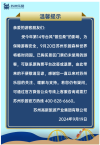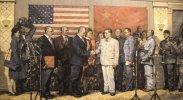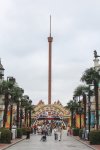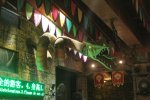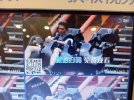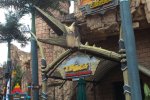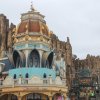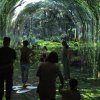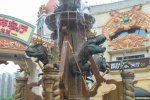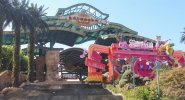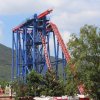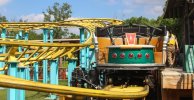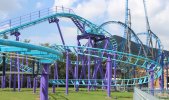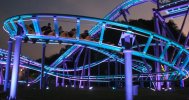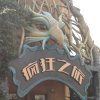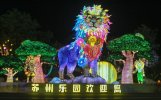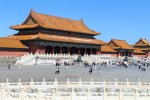NemesisRider
Roller Poster
Intro: A Family Affair
My Japan 2023 trip had been a blast – I’d seen some amazing sights, had plenty of fantastic food, and ridden some great coasters. At the start of the year, I knew I would have some time off between finishing my degree and starting full-time work in the Autumn, so doing some travel in this period was a no-brainer. I wanted to tick off another bucket list country and ideally ride some cool coasters in the process, so where better to do this than China?
As luck would have it, my brother Josh was also interested. Unlike myself, he’d been to China once before during Sixth Form, but saw very little beyond Beijing. He was looking to revisit the country in more depth, as well as practice some of the Mandarin he had spent nearly 2 years learning on-and-off.
Despite being siblings, I am distinctly a Type A man whereas Josh is much more Type B, so I took on the vast majority of itinerary and logistics planning. Most most of our time would be spent experiencing the country and visiting cultural sites together, but I also planned several days apart for me to go and ride some coasters whilst he did whatever he fancied. I ultimately settled on a mostly standard first-timer itinerary of Beijing, Xian and then Shanghai, albeit adding an extended stop in Suzhou so I could use it as a base for regional theme parks. As with my Japan TRs, I'm going to just focus on the coaster stuff for the sake of brevity.
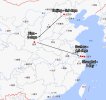
As a first timer in China, planning this trip was not the easiest and required an above-average amount of research. Sure, some parts are just like visiting any other country, like booking hotels with Expedia. However, China’s isolated digital ecosystem means that Westerners can’t use many of the services they’d typically rely on abroad like Google Maps. For me, necessary apps included LetsVPN to avoid the Great Firewall, Alipay and WeChat for payments, Didi for taxis, Amaps and Metroman for general navigation, and trip.com for attraction tickets. I particularly cannot stress the importance of Alipay and WeChat – China is basically a cashless society nowadays, debit/credit card alone is not widely accepted, and seemingly half of ticket sales are via WeChat/Alipay mini-apps. Once you get inside the ecosystem, it gets easier to find information too, as most useful websites are in Mandarin and harder to find via Google. With that said, if you do your homework, the vast majority of stuff should work as you’d hope and expect.
Time rolled by, as it does. Come September, I and my brother were fully equipped with tourist visas and ready to go East once again.
Day 1: Existential Crisis! At Sun Park
Our flight touched down in drizzly Beijing more or less on-time around 10am. Me and my brother very quickly became acquainted with the glories of Chinese bureaucracy, as we walked off the plane and straight into an hour-long queue to get through immigration at Daxing. This, naturally, also involved filling in an additional paper form demanding information which we’d definitely already given the Chinese government when we applied for our visas. The subsequent SIM card purchase setup process was mercifully quicker, albeit made more cumbersome by China Unicom’s requirement to register the SIM to a specific person and passport (to pre-empt the question, no, eSIM was not an option for us). In a final gut punch of faff, my brother revealed that he had not in fact pre-installed Alipay, further slowing down our journey towards the city centre. By the time we had dropped bags at the hotel and eaten some lunch, it was 3pm. My brother was exhausted, and the weather was still sufficiently uninspiring to visit one of the famous tourist spots, so I hopped on the metro and headed for some creds.
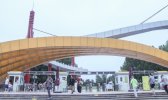
Chaoyang Park is a large public park in Eastern Beijing. On the Sunday I visited, there were plenty of families enjoying time together, as well as community stuff happening and even couples doing what looked like pre-wedding photos? Anyways, Sun Park is a set of mostly permanent rides looking within Chaoyang Park. They’re run by individual vendors so you will pay per ride.
Sun Park’s largest and most notable coaster is Flying Coaster, a Beijing Jiuhua Amusement Rides (catchy company name) knock-off of Toverland’s Booster Bike. I remember seeing a POV of this a good half-decade back and thinking it looked at least a decent laugh; it was time to put this hypothesis to the test.

Talk about a baptism in fire for Chinese coasters. After much hand-waving on my part, I paid the 50 RMB to ride and boarded the coaster. The restraints are surprisingly similar to those on Vekoma’s version, albeit with an extra seatbelt. Our train gradually thunked its way onto the launch track, where it proceeded to inexplicably wait for a good 30 seconds (maybe the bloke running it went for a cigarette). Eventually, an alarm sounded, then we were abruptly launched. The rest of the course is a hilariously brutal, Bizarro version of the Booster Bike layout, seemingly precisely misprofiled to induce just enough pain to be funny. Sure, it’s got no airtime or whatever, but it left me with a stupid grin on my face.
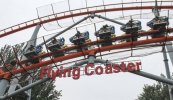
Unfortunately, it’s all very much downhill from here. Crazy Skateboard, a Beijing Jiuhua Amusement Rides knock-off spinner, rode like it was ready to fall apart at any moment. The restraints were awkward, it tracked poorly, and it just wasn’t much fun.
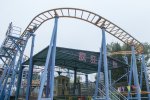
I also did a very bad powered coaster-esque, “shooting ride” thing. It was not worth my time or money.
The remaining coasters at Sun Park were all either shut or indisputably kiddie coasters, which I find more of an obligation than a pleasure of this hobby. In the face of such shamefulness, my typically impenetrable enthusiast code finally broke down. There was seemingly not another soul queuing for these coasters for literal children, so I couldn’t just slot myself innocuously onto an existing train. This was made worse by the fact I was still adjusting to the occasional stares that being a tall-ish white guy attracts in China and only just beginning to learn how to best handle the sizable language barrier for non-Mandarin speakers. So, I decided to go back to the hotel with 5/7 creds unridden. Even now, I wake up in cold sweats thinking about it – did I, in that moment of weakness, bring shame to the name of coaster nerds everywhere? Or did I make the right call to save my money and my dignity?
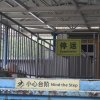
As I sat debating this with myself on the metro home, I realised I was very jet lagged, slightly delirious, and should probably just go to bed.
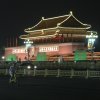
Next time: Sam visits his 2nd Universal park.
My Japan 2023 trip had been a blast – I’d seen some amazing sights, had plenty of fantastic food, and ridden some great coasters. At the start of the year, I knew I would have some time off between finishing my degree and starting full-time work in the Autumn, so doing some travel in this period was a no-brainer. I wanted to tick off another bucket list country and ideally ride some cool coasters in the process, so where better to do this than China?
As luck would have it, my brother Josh was also interested. Unlike myself, he’d been to China once before during Sixth Form, but saw very little beyond Beijing. He was looking to revisit the country in more depth, as well as practice some of the Mandarin he had spent nearly 2 years learning on-and-off.
Despite being siblings, I am distinctly a Type A man whereas Josh is much more Type B, so I took on the vast majority of itinerary and logistics planning. Most most of our time would be spent experiencing the country and visiting cultural sites together, but I also planned several days apart for me to go and ride some coasters whilst he did whatever he fancied. I ultimately settled on a mostly standard first-timer itinerary of Beijing, Xian and then Shanghai, albeit adding an extended stop in Suzhou so I could use it as a base for regional theme parks. As with my Japan TRs, I'm going to just focus on the coaster stuff for the sake of brevity.

As a first timer in China, planning this trip was not the easiest and required an above-average amount of research. Sure, some parts are just like visiting any other country, like booking hotels with Expedia. However, China’s isolated digital ecosystem means that Westerners can’t use many of the services they’d typically rely on abroad like Google Maps. For me, necessary apps included LetsVPN to avoid the Great Firewall, Alipay and WeChat for payments, Didi for taxis, Amaps and Metroman for general navigation, and trip.com for attraction tickets. I particularly cannot stress the importance of Alipay and WeChat – China is basically a cashless society nowadays, debit/credit card alone is not widely accepted, and seemingly half of ticket sales are via WeChat/Alipay mini-apps. Once you get inside the ecosystem, it gets easier to find information too, as most useful websites are in Mandarin and harder to find via Google. With that said, if you do your homework, the vast majority of stuff should work as you’d hope and expect.
Time rolled by, as it does. Come September, I and my brother were fully equipped with tourist visas and ready to go East once again.
Day 1: Existential Crisis! At Sun Park
Our flight touched down in drizzly Beijing more or less on-time around 10am. Me and my brother very quickly became acquainted with the glories of Chinese bureaucracy, as we walked off the plane and straight into an hour-long queue to get through immigration at Daxing. This, naturally, also involved filling in an additional paper form demanding information which we’d definitely already given the Chinese government when we applied for our visas. The subsequent SIM card purchase setup process was mercifully quicker, albeit made more cumbersome by China Unicom’s requirement to register the SIM to a specific person and passport (to pre-empt the question, no, eSIM was not an option for us). In a final gut punch of faff, my brother revealed that he had not in fact pre-installed Alipay, further slowing down our journey towards the city centre. By the time we had dropped bags at the hotel and eaten some lunch, it was 3pm. My brother was exhausted, and the weather was still sufficiently uninspiring to visit one of the famous tourist spots, so I hopped on the metro and headed for some creds.

Chaoyang Park is a large public park in Eastern Beijing. On the Sunday I visited, there were plenty of families enjoying time together, as well as community stuff happening and even couples doing what looked like pre-wedding photos? Anyways, Sun Park is a set of mostly permanent rides looking within Chaoyang Park. They’re run by individual vendors so you will pay per ride.
Sun Park’s largest and most notable coaster is Flying Coaster, a Beijing Jiuhua Amusement Rides (catchy company name) knock-off of Toverland’s Booster Bike. I remember seeing a POV of this a good half-decade back and thinking it looked at least a decent laugh; it was time to put this hypothesis to the test.

Talk about a baptism in fire for Chinese coasters. After much hand-waving on my part, I paid the 50 RMB to ride and boarded the coaster. The restraints are surprisingly similar to those on Vekoma’s version, albeit with an extra seatbelt. Our train gradually thunked its way onto the launch track, where it proceeded to inexplicably wait for a good 30 seconds (maybe the bloke running it went for a cigarette). Eventually, an alarm sounded, then we were abruptly launched. The rest of the course is a hilariously brutal, Bizarro version of the Booster Bike layout, seemingly precisely misprofiled to induce just enough pain to be funny. Sure, it’s got no airtime or whatever, but it left me with a stupid grin on my face.

Unfortunately, it’s all very much downhill from here. Crazy Skateboard, a Beijing Jiuhua Amusement Rides knock-off spinner, rode like it was ready to fall apart at any moment. The restraints were awkward, it tracked poorly, and it just wasn’t much fun.

I also did a very bad powered coaster-esque, “shooting ride” thing. It was not worth my time or money.
The remaining coasters at Sun Park were all either shut or indisputably kiddie coasters, which I find more of an obligation than a pleasure of this hobby. In the face of such shamefulness, my typically impenetrable enthusiast code finally broke down. There was seemingly not another soul queuing for these coasters for literal children, so I couldn’t just slot myself innocuously onto an existing train. This was made worse by the fact I was still adjusting to the occasional stares that being a tall-ish white guy attracts in China and only just beginning to learn how to best handle the sizable language barrier for non-Mandarin speakers. So, I decided to go back to the hotel with 5/7 creds unridden. Even now, I wake up in cold sweats thinking about it – did I, in that moment of weakness, bring shame to the name of coaster nerds everywhere? Or did I make the right call to save my money and my dignity?

As I sat debating this with myself on the metro home, I realised I was very jet lagged, slightly delirious, and should probably just go to bed.

Next time: Sam visits his 2nd Universal park.
Last edited:










